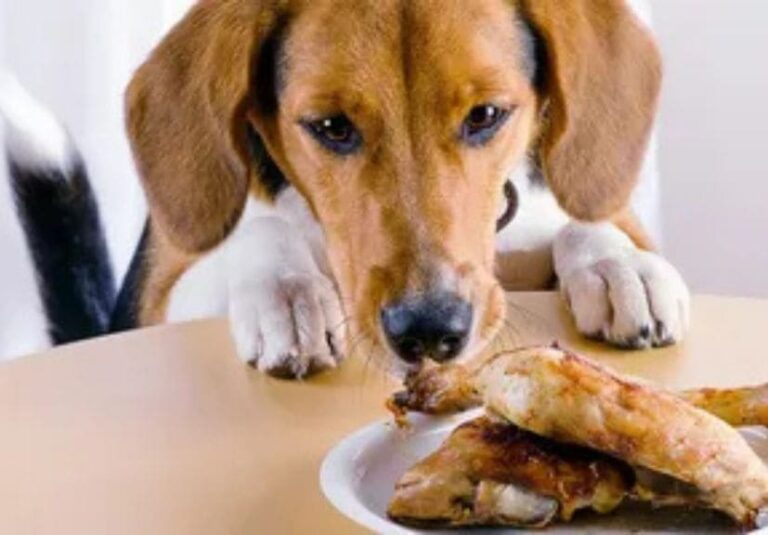We’ll cover the importance of sticking to a feeding schedule, avoiding feeding table scraps, and using puzzle toys for mental stimulation. We’ll also discuss the benefits of monitoring treatment intake, ensuring plenty of exercise, and considering low-calorie, high-fiber treats.
Additionally, we’ll highlight the importance of always providing fresh water, ruling out medical causes promptly, avoiding overfeeding, and consulting with a veterinarian for guidance. Let’s detail these tips to help your furry friend maintain a healthy and happy life.
Tips To Manage Constantly Hungry Dogs
Managing hungry canines can be challenging but crucial for their health and well-being. In the following passages, we’ll share expert tips to help you manage constantly hungry dogs effectively, covering everything from feeding schedules to exercise and veterinary care, ensuring your furry friend remains happy and healthy.
Stick to a Feeding Schedule
Firstly, it’s essential to stick to a feeding schedule. Dogs thrive on routine, and feeding them at the exact times each day helps regulate their appetite and behavior. This prevents increased appetite and keeps their blood sugar levels stable. A regular schedule also helps monitor their food intake and identify any changes in their hunger patterns.
Avoid Feeding Table Scraps
Next, avoid feeding your dog table scraps. While sharing your food with your furry friend might be tempting, this can lead to overfeeding and weight gain. Human food often contains ingredients unsuitable for dogs and can upset their gastrointestinal systems. Instead, stick to their regular diet and ensure they receive the right balance of nutrients.
Use Puzzle Toys for Mental Stimulation
To manage a hungry dog, consider using puzzle toys. These toys provide mental stimulation and can make feeding time more engaging. By working for their food, dogs can use their brains and slow their eating, promoting a sense of satiety. This can be especially useful for breeds prone to polyphagia (excessive hunger).
Monitor Treat Intake
Treats are a great way to reward good behavior, but monitoring their intake is essential. Overfeeding treats can lead to excessive calorie consumption and weight gain. Opt for low-calorie, high-fiber treats that promote nutrition without adding too many calories. Always watch the number of treats given daily to maintain a balanced diet.
Ensure Plenty of Exercise
Exercise plays a crucial role in managing a hungry dog. Regular physical activity helps burn off excess calories and reduces stress and anxiety. Exercise promotes overall health and well-being, keeping your dog fit and preventing weight gain. Ensure your pet gets enough exercise through walks, playtime, and interactive activities.
Consider Low-Calorie, High-Fiber Treats
When choosing treats, go for low-calorie, high-fiber options. These treats are healthier and help keep your dog feeling complete for extended periods. High-fiber foods are great for digestion and can help manage increased appetite by promoting a sense of fullness.
Provide Fresh Water at all Times
Always provide fresh water for your dog. Sometimes, dogs might appear hungry when they are thirsty. Ensuring they have access to clean water can help manage their appetite and prevent dehydration. Proper hydration is critical to maintaining a healthy diet and overall nutrition.
Rule Out Medical Causes Promptly
If your dog seems perpetually hungry, it’s essential to rule out any underlying medical conditions. Increased appetite can be a symptom of various health issues such as diabetes, Cushing’s disease, or exocrine pancreatic insufficiency. Consulting with a veterinarian can help diagnose and treat these conditions effectively.
Avoid Overfeeding
Overfeeding your dog is easy, especially when they give you those pleading eyes. However, overfeeding can lead to obesity and related health issues. Stick to the recommended portion sizes for your dog’s weight and breed. If you need clarification on the right amount, your vet can provide guidance based on your dog’s needs.
Consult with a Veterinarian for Guidance
Lastly, always consult with a veterinarian for personalized guidance. Your vet can help you determine your dog’s proper diet and feeding schedule based on weight, breed, and health status. They can also suggest suitable treatments if your dog’s increased appetite is due to an underlying health issue.
Additional Tips and Considerations
Understanding the reasons behind your dog’s hunger can make managing it much more manageable. For instance, some dogs may experience hunger due to anxiety or boredom. Providing ample mental and physical stimulation can help alleviate these feelings and reduce increased appetite.
Certain breeds are more prone to weight gain and medical conditions such as hypoglycemia or diabetes in dogs. Monitoring your dog’s blood sugar levels and maintaining a balanced diet are crucial. Dogs with conditions like exocrine pancreatic insufficiency or gastrointestinal disorders might require special diets to manage their symptoms.
Regular check-ups and diagnostic imaging can help detect issues like hyperadrenocorticism (Cushing’s disease) early. These conditions can affect the pancreas, adrenals, and other organs, impacting your dog’s overall health and nutrition.
In some cases, dietary changes can help manage increased appetite. For instance, switching to a high-fiber diet can promote a sense of fullness and reduce hunger. Including the right balance of carbs, proteins, and fats in your dog’s diet ensures they receive all the essential nutrients.
Lastly, don’t forget the importance of addressing stress and anxiety in dogs. Like humans, dogs can experience stress that affects their appetite and behavior. Providing a calm and stable environment can help manage these issues effectively.
Conclusion
In conclusion, manage constantly hungry dogs by combining proper nutrition, regular exercise, mental stimulation, and veterinary care. By following these tips and working closely with your vet, you can effectively manage your dog’s hunger and ensure it stays healthy, happy, and well-fed. Understanding your dog’s needs and providing a balanced diet is vital to successfully managing a perpetually hungry pet.
Why does my dog always seem to be hungry?
Dogs may seem constantly hungry due to reasons like insufficient nutrition, lack of exercise, medical conditions such as diabetes or hyperadrenocorticism, or behavioral issues like boredom or anxiety. Consulting a veterinarian can help determine the cause and provide appropriate solutions. Wondering, “Why is my dog always hungry?” Seek professional advice.
How Do Vets Diagnose Increased Appetite in Dogs?
When dealing with a constantly hungry dog, veterinarians use various diagnostic methods to identify the underlying cause. These methods may include:
- Physical Examination
- Blood Tests (e.g., glucose levels, thyroid function)
- Urine Analysis
- Fecal Examination
- Imaging (X-rays, ultrasound)
When a dog is satisfied, do they quit eating?
If your dog is already full, they may stop eating. Although managing your dog’s nutrition may be challenging if they are devouring your leftovers, overindulging in food has several immediate and long-term hazards.
How can I tell whether I’m giving my dog enough food?
Is your dog looking chunky around the middle? It might mean it needs more food. A healthy dog should have a waist that curves in a bit, not a straight line. You should also be able to feel their ribs quickly but not see them sticking out. Patchy fur loss can also indicate they are not getting the proper nutrients.




